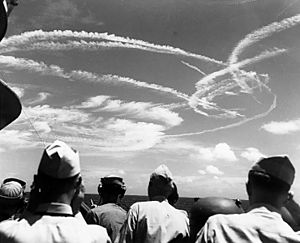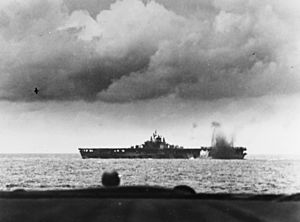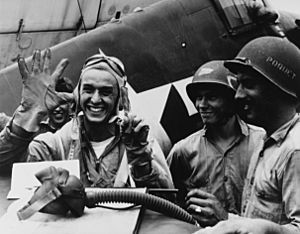Battle of the Philippine Sea facts for kids
Quick facts for kids Battle of the Philippine Sea |
|||||||
|---|---|---|---|---|---|---|---|
| Part of World War II, Pacific War | |||||||
 The carrier Zuikaku (center) and two destroyers under attack by U.S. Navy carrier aircraft, June 20, 1944 |
|||||||
|
|||||||
| Belligerents | |||||||
| Commanders and leaders | |||||||
| Strength | |||||||
| 7 fleet carriers, 8 light carriers, 7 battleships, 79 other ships, 28 submarines, 956 planes |
5 fleet carriers, 4 light carriers, 5 battleships, 43 other ships, 450 carrier-based planes, 300 land-based planes |
||||||
| Casualties and losses | |||||||
| 123 planes destroyed (about 80 of whose crews survived) | 3 fleet carriers sunk, 2 oilers sunk, about 600 planes destroyed, 6 other ships heavily damaged |
||||||
The Battle of the Philippine Sea was a very important naval battle during World War II. It took place between the navies of the United States and Japan. This huge battle happened on June 19 and 20, 1944, near the Mariana Islands. It involved two large naval forces and many Japanese aircraft flying from land bases.
The battle was a major defeat for the Japanese Navy. They lost three aircraft carriers and about 600 aircraft in just two days. This happened because Japanese airplanes were older. Their pilots also had less training compared to the American forces. After this battle, the Japanese Navy was almost completely destroyed. This victory for the Allied forces helped open the way for the invasion of Iwo Jima.
Contents
What Was the Battle of the Philippine Sea?
The Battle of the Philippine Sea was a huge naval and air battle. It was fought in the Pacific Ocean during World War II. The main goal for the Americans was to capture the Mariana Islands. These islands were important for setting up airfields closer to Japan.
Who Fought in This Battle?
The battle was fought between the United States Navy and the Imperial Japanese Navy.
- The U.S. Navy was led by Admiral Raymond A. Spruance. His fleet was called the Fifth Fleet.
- The Imperial Japanese Navy was led by Admiral Jisaburō Ozawa. His fleet was known as the Combined Fleet.
Where and When Did It Happen?
The battle took place in the Philippine Sea. This is a large area of the western Pacific Ocean. The fighting happened near the Mariana Islands. The main days of combat were June 19 and 20, 1944.
Why Was This Battle Important?
This battle was very important for several reasons. It was a major turning point in the Pacific War.
Controlling the Mariana Islands
The United States wanted to take control of the Mariana Islands. These islands included Saipan, Tinian, and Guam. Capturing them would give the U.S. important airfields. From these airfields, American bombers could reach Japan directly.
Japan's Last Big Carrier Battle
The Japanese Navy tried to stop the American invasion. They planned a large attack using their aircraft carriers. This battle was one of Japan's last major attempts to use its carrier fleet in a big way.
How Did the Battle Unfold?
The battle involved massive air attacks and naval maneuvers. It was a complex fight over two days.
The First Day: June 19, 1944
On June 19, Japanese planes launched several attacks. They flew from their carriers and land bases. The American forces were ready for them.
The "Great Mariana Turkey Shoot"
American pilots were better trained and had newer planes. Their planes, especially the Grumman F6F Hellcat, were very effective. The American pilots shot down hundreds of Japanese planes. This day became known as the "Great Mariana Turkey Shoot." It was called this because so many Japanese planes were destroyed.



The Second Day: June 20, 1944
On the second day, American submarines played a key role. They found and attacked Japanese carriers.
Submarine Attacks
- The American submarine USS Albacore attacked the Japanese carrier Taihō. The Taihō was the newest and largest Japanese carrier. It sank later due to damage and explosions.
- Another submarine, USS Cavalla, attacked the carrier Shōkaku. The Shōkaku was a veteran carrier from the Pearl Harbor attack. It also sank after being hit.
American Air Strikes
Late on June 20, American planes found the main Japanese fleet. They launched a long-range attack. Even though it was getting dark, American pilots attacked the remaining Japanese ships. They sank another carrier, the Hiyō.
What Were the Results of the Battle?
The Battle of the Philippine Sea was a huge victory for the United States. It was a disaster for Japan.
Heavy Losses for Japan
- Japan lost three aircraft carriers: Taihō, Shōkaku, and Hiyō.
- They also lost about 600 aircraft. Many experienced Japanese pilots were killed.
- Two oil tankers were sunk, and six other ships were badly damaged.
American Victory
- The United States lost only 123 planes. Most of their pilots survived.
- No American ships were sunk.
Impact on the War
This battle severely weakened the Japanese Navy. They lost most of their carrier aircraft and many skilled pilots. This made it very hard for Japan to fight back effectively in future naval battles. The victory allowed the U.S. to continue its island-hopping campaign towards Japan.
Images for kids
-
Japanese Carrier Division Three under attack by United States Navy aircraft from Task Force 58, late afternoon, June 20, 1944. The heavy cruiser circling at right, nearest to the camera, is either Maya or Chōkai. Beyond that is the small aircraft carrier Chiyoda.
See also
 In Spanish: Batalla del mar de Filipinas para niños
In Spanish: Batalla del mar de Filipinas para niños




